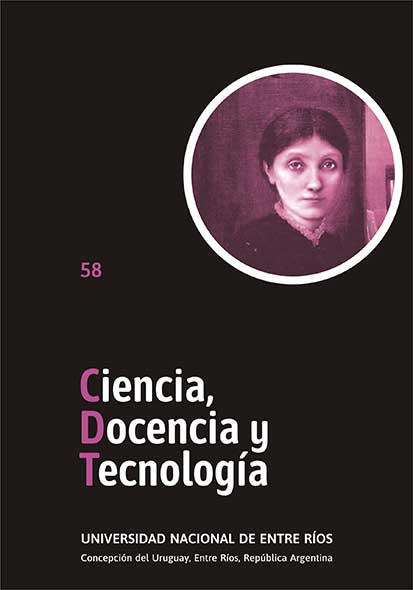Conservación de nuggets de pollo con bajo contenido en sodio y formulados con fibra de trigo
DOI:
https://doi.org/10.33255/3058/436Palabras clave:
nuggets de pollo, fibra de trigo, bajo en sodio, conservación en congelaciónResumen
Los nuggets de pollo son bocaditos que se conservan en congelación. Elaborando nuggets con fibra dietaria y bajos en sodio, se pondría a disposición un alimento más saludable. Los procesos de rancidez se inician rápidamente en los productos con carne picada y la reducción del sodio podría inducir desarrollos microbianos. Este trabajo evalúa el efecto de la incorporación de fibra de trigo sobre la conservación de nuggets bajos en sodio por doce meses. Se elaboró un lote con 0% de fibra de trigo y 1,6% de NaCl (formulación estándar), y otro con 2% de fibra y 0,8% de NaCl. Se determinaron TBARS, recuentos microbiológicos y evaluación sensorial. Los datos se analizaron mediante ANOVA. Como resultado, los nuggets con 2% de fibra y reducidos en sodio no presentaron cambios a nivel oxidativo, sensorial y microbiológico durante la conservación, mostrando un comportamiento similar al de los productos con la formulación estándar.
Descargas
Citas
ABERLE, E.; FORREST, J.; GERRARD, D.; MILLS, E.; HELDRICK, H.; JUDGE, M. et al. (2001). Principles of Meat Science. 4º ed. Iowa: Kendall/Hunt Publishing Co.
AMERICAN PUBLIC HEALTH ASSOCIATION, American Water Works Association and Water Environment Federation (1999). SM 3030 E Nitric Acid Digestion, Preliminary treatment of samples. En Standard Methods for the Examination of Water and Wastewater. Washington DC: APHA
AOAC (2007). Official methods of analysis. Arlington VA: Association of Official Analytical Chemists
ARIHARA, K. (2006). Strategies for designing novel functional meat products. En: Meat Science, 74: 219-229.
BONATO, P.; PERLO, F.; TEIRA, G.; FABRE, R.; KUEIDER, S. (2006a). Características texturales de nuggets de pollo elaborados con carne de ave mecánicamente recuperada en reemplazo de carne manualmente deshuesada. En: Ciencia, Docencia y Tecnología, 32: 219-239
BONATO, P.; PERLO, F.; TEIRA, G.; FABRE, R.; KUEIDER, S. (2006b). Nuggets formulados con carne de ave mecánicamente recuperada y lavada: estabilidad durante el almacenamiento en congelación. En: Ciencia y Tecnología Alimentaria, 5: 112-117.
BONATO, P.; PERLO, F.; FABRE, R.; TEIRA, G. TISOCCO, O.; TITO, B. (2014). “Quality characteristics of chicken nuggets with reduced amounts of sodium chloride and added dietary fiber”. En: 60th International Congress of Meat Science and Technology, 17-22 August 2014, Uruguay
BRITOS, S.; SARAVÍ, A.; CHICHIZOLA, N.; VILELLA, F. (2012). Hacia una alimentación saludable en la mesa de los argentinos. Buenos Aires: Orientación Gráfica Editora.
BUSS, D.; TYLER, H.; BARBER, S.; CRAWLEY, H. (1987). Manual de Nutrición. Zaragoza: Ed. Acribia.
CASTAÑOLA, J.; MAGARIÑOS, M.; ORTIZ, S. (2004). Patrón de ingesta de vegetales y frutas en adolescentes en el área metropolitana de Buenos Aires. En: Archivos argentinos de pediatría, 102: 265-270.
CÓDIGO ALIMENTARIO ARGENTINO [en línea]. Buenos Aires, Administración Nacional de medicamentos, alimentos y tecnología médica. Recuperado de: http://www.anmat.gov.ar/alimentos/normativas_alimentos_caa.asp [19 Febrero 2016].
DAS, A.; NATH, D.; KUMARI, S.; SAHA, R. (2013). Effect of fermented bamboo shoot on the quality and shelf life of nuggets prepared from desi spent hen. En: Vet World, 6(7): 419-423.
DESMOND, E. (2006). Reducing salt: a challenge for the meat industry. En: Meat Science, 74: 13-18.
GUARDIÃ, M.; GUERRERO, L.; GELABERT, J.; GOU, P.; ARNAU, J. (2006). Consumer attitude towards sodium reduction in meat products and acceptability of fermented sausages with reduced sodium content. En: Meat Science, 73: 484-490.
GUERRA, M.; MARTÍN, M.; VALLADARES, C.; DE HOMBRE, R.; BERRERO, E. (1997). Algunas características de los nuggets de pollo. En: Alimentaria, 34(282), 89-92.
HERMANSEN, K. (2000). Diet, blood pressure and hypertension. En: British Journal of Nutrition, 83, Suppl. 1: S113-S119
ICMSF (International Commission on Microbiological Specifications for Foods) (2004). Microorganismos de los alimentos. 7. Análisis microbiológico en la gestión de la seguridad alimentaria. Zaragoza: Ed. Acribia.
INSTITUTE OF MEDICINE OF THE NATIONAL ACADEMIES (2010). Strategies to Reduce Sodium Intake in the United States, ed. by Henney JE, Taylor CL and Boon CS. Washington DC: The National Academies Press
KINGSTON, E.; MONAHAN, F.; BUCKLEY, D.; LYNCH, P. (1998). Lipid oxidation in cooked pork as affected by vitamin E, cooking and storage conditions. En: Journal of Food Science, 63: 386-389.
LAI, S.; GRAY, J.; SMITH, D.; BOOREN, A.; CRACKEL, R. & BUCKLEY, D. (1991). Effects of oleoresin rosemary, tertiary butylhydroxyquinone and sodium tripolyphosphate on the development of oxidative rancidity in restructured chicken nuggets. En: Journal of Food Science, 56: 616-620.
LEY NACIONAL DE PROMOCIÓN DE LA REDUCCIÓN DEL CONSUMO DE SODIO EN LA POBLACIÓN. Ley 26.905. Boletín Oficial, 16 de diciembre de 2013. Recuperado de: http://www.infojus.gob.ar/legislacion/ley-nacional-26905-promocion_ reduccion_consumo_sodio.htm [Disponible en: 19 feb. 2016].
LINNEMANN, A.; BENNER, M.; VERKERK, R.; VAN BOEKEL, M. (2006). Consumer-driven food product development. En: Trends in Food Science & Technology, 17: 184-190.
MARSH, A. (1983). Processes and formulation that affect the sodium content of foods. En: Food Technology, 37:45-49.
MINISTERIO DE SALUD, Dirección de Promoción de la Salud y Control de Enfermedades No Transmisibles. (2015). Menos Sal, más vida. Recuperado de: http://www.msal.gob.ar/ent/index.php/informacion-para-ciudadanos/menos-sal--vida [10 Diciembre 2015].
MITSUMOTO, M.; GRADY, M.; KERRY, J.; BUCKLEY, J. (2005). Addition of tea catechins and vitamin C on sensory evaluation, colour and lipid stability during chilled storage in cooked or raw beef and chicken patties. En: Meat Science, 69: 773-779.
MURPHY, S.; GILROY, D.; KERRY, J.; BUCKLEY, D.; KERRY, J. (2004). Evaluation of surimi, fat and water content in a low/ no added pork sausage formulation using response surface methodology. En: Meat Science, 66: 689-701.
PERLO, F.; BONATO, P.; TEIRA, G.; FABRE, R.; KUEIDER, S. (2006). Physicochemical and sensory properties of chicken nuggets with washed mechanically deboned chicken meat. En: Meat Science, 72: 785-788.
POLIZER, Y.; POMPEU, D.; HIRANO, M.; ALVARENGA FREIRE, M.; TRINDADE, M. (2015). Development and evaluation of chicken nuggets with partial replacement of meat and fat by pea fibre. En: Brazilian Journal of food technology, 18: 62-69.
RIVELLESE, A.; RICCARDI, G.; GIACCO, A.; POSTIGLIONE, A.; MASTRANZO, P.; MATTIOLI, P. (1983). Reduction of risk factors for atherosclerosis in diabetic patients treated with a high-fiber diet. En: Preventive Medicine, 12(1): 128-132.
ROSMINI, M.; PERLO, F.; PÉREZ-ALVAREZ, J.; PAGÁN-MORENO, M.; GAGO-GAGO, A.; LÓPEZ-SANTOVEÑA, F et al. (1996). TBA test by an extractive method applied to pâté. En: Meat Science, 42: 103-110.
RUUSUNEN, M.; VAINIONPAA, J.; PUOLANNE, E.; LYLY, M.; LAHTEENMAKI, L.; NIEMISTO, M. et al. (2003). Effect of sodium citrate, carboxymethyl cellulose and carrageenan levels on quality characteristics of low-salt and low-fat bologna type sausages. En: Meat Science, 64: 371-381.
SCHNEEMAN, B. (1998). Dietary fiber and gastrointestinal function. En: Nutrition Research, 18(4): 625-632.
SOFOS, J. 1984. Antimicrobial effects of sodium and other ions in foods: a review. En: Journal of Food Safety, 6:45-78.
TANG, S.; KERRY, J.; SHEEHAN, D.; BUCKLEY, J.; MORRISSEY, P. (2001). Antioxidative effect of added tea catechins on susceptibility of cooked red meat, poultry and fish patties to lipid oxidation. En: Food Research International, 34: 651-657.
THATCHER, F. and Clark, D. (1973). Análisis Microbiológico de los Alimentos. Zaragoza: Editorial Acribia.
VAN VLIET, B.; CAMPBELL, N. (2011). Efforts to Reduce Sodium Intake in Canada: Why, What, and When? Review. En: Canadian Journal of Cardiology, 27: 437-445.
WEISS, J.; GIBIS, M.; SCHUH, V.; SALMINEN, H. (2010). Advances in ingredient and processing systems for meat and meat products. En: Meat Science, 86: 196-213.
Publicado
Cómo citar
Número
Sección
Licencia
Los autores conservan los derechos de autor y garantizan a la revista el derecho de ser la primera publicación del trabajo, al igual que licenciarlo bajo una Creative Commons Attribution License que permite a otros compartir el trabajo con un reconocimiento de la autoría del trabajo y la publicación inicial en esta revista. Todo el contenido es publicado bajo licencia internacional Creative Commons 4.0: Atribución-No Comercial-Compartir Igual.






